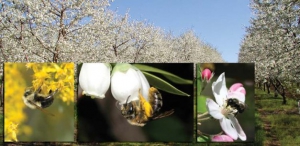
Left: Bumblebees are highly efficient pollinators of many crops, but their wild colonies live through the whole season. Providing a mix of wildflowers on the farm, such as this goldenrod that blooms in the fall, can provide the much-needed pollen and nectar for these bees and honeybees that are building their energy for the winter.. Center: Many wild bees are solitary species that make their nests in the ground. The Andrena bees are important pollinators of many berry and tree fruit crops. They need open patches of well-drained soil for nesting, and sometimes nest in the weed-free strip under the crop. Right: The blue orchard bee is well-adapted to pollination of tree fruit and nut crops. Researchers are studying how best to release it and whether flowering habitat near orchards can increase this bee’s reproduction.
When it comes to likeable insects, even Monarch butterflies have to take a back seat to honeybees.
But in recent years, these bees have been sorely kicked about by viruses and diseases, parasitic mites, and mysterious syndromes like colony collapse disorder. These maladies have spawned some heretical thoughts, like this one:
Hey, there were flowering plants in America long before the Europeans brought honeybees over here, and they set seeds and survived from the work of wild bees. Maybe honeybees are not so essential after all.
That may be the case in some crop situations, but for many intensively managed crops, there are millions of flowers to visit per acre. So, what is a grower to do when deciding on whether to rely on wild bees or bring in honeybees? The answer is an integrated approach—encouraging native bees and giving honeybees the help they need to prosper.
Last October, the U.S. Department of Agriculture’s Specialty Crop Research Initiative awarded $1.6 million for the first year of a five-year research and extension project on Integrated Crop Pollination. The idea is to focus on developing economical strategies to make sure crops get pollinated reliably each year, whether it takes honeybees, wild bees, or alternative managed bees like bumblebees and mason bees, or a combination of approaches.
The project will be led by Michigan State University and headed by extension entomologist Dr. Rufus Isaacs. It will include collaborators from all over the country—Washington, Oregon, Michigan, Pennsylvania, New York, Florida, Utah, Vermont, Illinois, and the Canadian province of British Columbia.
“Researchers in many of these states and provinces have been studying the problem independently for five years and more, but now it’s under one roof and focused on some common goals,” Isaacs said.
The goals are to develop region- and crop-specific management approaches to diversify pollination sources and maintain consistent crop yields.
They will examine adding habitat for bees to provide them with food when crops are not in bloom. The extension component of the project will focus on ways to manipulate farm landscapes to support native bee and honeybee populations.
The project team also includes commercial pollination suppliers and an advisory committee of stakeholders to provide input and feedback.
“It is exciting to receive this funding and to start this project that we expect to benefit the production of these crops that support the health of our nation,” Isaacs said at the time the grant was announced. “People are consuming more fruits, vegetables, and nuts, and these all depend on pollination. As demand increases, it will be essential that growers have the tools needed to ensure they can continue to supply this demand.”
Native bees
Workers at the Isaacs Lab at Michigan State University began working with native bees several years ago. Julianna Tuell (now Julianna Wilson) surveyed blueberry plantations to identify native bees that were working there and where they lived. She found many were ground-nesting bees that lived right in the plantations. Blueberries—like other berries— seem to respond well to added pollinators, and most blueberry growers rent honeybees to pollinate, but get a lot of their pollination from native bees, too.
Dr. Nikki Rothwell, coordinator of the Northwest Michigan Horticultural Research Station in Traverse City, has worked with growers for several years to establish semimanaged colonies of blue orchard bees. Nesting materials are provided, and growers can determine spring emergence by keeping nests cold until the desired date.
Dr. David Biddinger at Penn State University, speaking at the Mid-Atlantic Fruit and Vegetable Convention in Hershey, Pennsylvania, in January, said that they had surveyed apple growers in Pennsylvania and found that half of them never rented any honeybees but had not suffered any yield penalties at all. Many of them were smaller growers, he said, and many of their orchards were surrounded by nonorchard habitat.
“By combining the expertise of many excellent researchers working in crop pollination, we plan to develop and deliver context-specific Integrated Crop Pollination recommendations on how to most effectively harness the potential of native bees for crop pollination,” Isaacs said.
“We define ICP as the combined use of different pollinator species, habitat augmentation, and crop management practices to provide reliable and economical pollination of crops.
“There is a lot that goes into effective crop pollination. Honeybees are the workhorses that get the majority of pollination done in many situations. This project will explore the what and how of pollinator diversification, to provide growers with an economic basis for making decisions about where to spend their pollination dollars.”
The project has a Web site, www.icpbees.org.

Leave A Comment